Opportunities for Recycling PV Glass and Coal Fly Ash into Zeolite Materials Used for Removal of Heavy Metals (Cd, Cu, Pb) from Wastewater
Abstract
:1. Introduction
2. Materials and Methods
2.1. Raw Compounds
2.2. Zeolite Materials Synthesis and Characterization
2.3. Material Characterization
3. Results
3.1. Crystalline Structure of Substrates
3.2. Morphological and Surface Energy Properties
3.2.1. Surface Morphology
3.2.2. The Surface Energy
3.2.3. FT-IR Evaluation
3.3. Adsorption Experiments
3.3.1. Adsorption Efficiency Function of the Contact Time in Monocation Solutions
3.3.2. Evaluation of the Removal Percentage and Contact Period in the Presence of Three-Cation Solutions
3.3.3. The Correlations between the Adsorbent Mass and Adsorption Efficiency
3.3.4. Influence of the Initial Heavy Metals Concentration
3.3.5. Establishing the PZC Values of the Substrates
3.4. Modeling of Adsorption Kinetics
3.5. Adsorption Batch Isotherms
4. Conclusions
Author Contributions
Funding
Institutional Review Board Statement
Informed Consent Statement
Data Availability Statement
Conflicts of Interest
References
- Liang, J.; Yuan, Y.; Zhang, Z.; You, S.; Yuan, Y. Modeling a Three-Stage Biological Trickling Filter Based on the A2O Process for Sewage Treatment. Water 2021, 13, 1152. [Google Scholar] [CrossRef]
- Jin, X.; Che, R.; Yang, J.; Liu, Y.; Chen, X.; Jiang, Y.; Liang, J.; Chen, S.; Su, H. Activated Carbon and Carbon Quantum Dots/Titanium Dioxide Composite Based on Waste Rice Noodles: Simultaneous Synthesis and Application in Water Pollution Control. Nanomaterials 2022, 12, 472. [Google Scholar] [CrossRef]
- Yang, T.; Chen, M.; Wu, S. Removal Effect of Basic Oxygen Furnace Slag Porous Asphalt Concrete on Copper and Zinc in Road Runoff. Materials 2021, 14, 5327. [Google Scholar] [CrossRef]
- Singh, K.K.; Rastogi, R.; Hasan, S.H. Removal of cadmium from wastewater using agricultural waste rice polish. J. Hazard. Mater. 2005, 121, 51–58. [Google Scholar] [CrossRef]
- Guo, J.; Feng, R.; Ding, Y.; Wang, R. Applying carbon dioxide, plant growth-promoting rhizobacterium and EDTA can enhance the phytoremediation efficiency of ryegrass in a soil polluted with zinc, arsenic, cadmium and lead. Environ. Manag. J. 2014, 14, 1–8. [Google Scholar] [CrossRef]
- Karim, K.; Guha, S.; Beni, R. Comparative Analysis of Water Quality Disparities in the United States in Relation to Heavy Metals and Biological Contaminants. Water 2020, 12, 967. [Google Scholar] [CrossRef] [Green Version]
- Molaudzi, N.R.; Ambushe, A.A. Sugarcane Bagasse and Orange Peels as Low-Cost Biosorbents for the Removal of Lead Ions from Contaminated Water Samples. Water 2022, 14, 3395. [Google Scholar] [CrossRef]
- Liu, Y.; Yan, C.; Zang, Z.; Wang, H.; Zhou, S.; Zhou, W. A comparative study on fly ash, geopolymer and faujasite block for Pb removal from aqueous solution. Fuel 2016, 185, 181–189. [Google Scholar] [CrossRef]
- Duta, A.; Andronic, A.; Enesca, A. The influence of low irradiance and electrolytes on the mineralization efficiency of organic pollutants using the Vis-active photocatalytic tandem CuInS2/TiO2/SnO2. Catal. Today 2017, 300, 18–27. [Google Scholar] [CrossRef]
- Patel, H.; Vashi, R.T. Treatment of textile wastewater by adsorption and coagulation. E-J. Chem. 2010, 7, 1468–1476. [Google Scholar] [CrossRef]
- Li, Y.Y.; Cao, Y.; Yue, M.B.; Yang, J.; Zhu, J.H. Hierarchical Composites to Reduce N-Nitrosamines in Cigarette Smoke. Materials 2015, 8, 1325–1340. [Google Scholar] [CrossRef] [Green Version]
- Wake, H. Oil refineries: A review of their ecological impacts on the aquatic environment. Estuar. Coast. Shelf Sci. 2005, 62, 13–140. [Google Scholar] [CrossRef]
- Nuhoglu, Y.; Malkoc, E. Thermodynamic and kinetic studies for environmentally friendly Ni(II) biosorption using waste pomace of olive oil factory. Bioresour. Technol. 2009, 100, 2375–2380. [Google Scholar] [CrossRef]
- Mohammadi, T.; Razmi, A.; Sadrzadeh, M. Effect of operating parameters on Pb2+ separation from wastewater using electrodialysis. Desalination 2004, 167, 379–385. [Google Scholar] [CrossRef]
- Pratiwi, D.M.; Herdiansyah, H. Development of desalination technology using reverse osmosis membrane for the provision of clean water in DKI Jakarta. AIP Conf. Proc. 2018, 2026, 020027. [Google Scholar]
- Kowalska, I. Surfactant removal from water solutions by means of ultrafiltration and ion-exchange. Desalination 2008, 222, 351–357. [Google Scholar] [CrossRef]
- Visa, M. Synthesis and characterization of new zeolite materials obtained from fly ash for heavy metals removal in advanced wastewater treatment. J. Powder Technol. 2016, 294, 338–347. [Google Scholar] [CrossRef]
- Abdolali, A.; Ngo, H.H.; Guo, W.; Lu, S.; Chen, S.S.; Nguyen, N.C.; Zhang, X.; Wang, J.; Wu, Y. A break through biosorbents in removing heavy metals: Equilibrium, kinetic, thermo-dinamic and mechanism analyses in a lab-scale study. Sci. Total Environ. 2016, 542, 603–611. [Google Scholar] [CrossRef]
- Visa, M. Tailoring fly ash activated with bentonite as adsorbent for complex wastewater treatment. J. Appl. Surf. Sci. 2012, 263, 753–762. [Google Scholar] [CrossRef]
- Hong, S.; Wen, C.; He, J.; Gan, F.; Hob, Y.S. Adsorption thermodynamics of Methylene Blue onto bentonite. J. Hazard. Mater. 2009, 167, 630–633. [Google Scholar] [CrossRef]
- Sljivi, M.; Smiciklas, I.; Pejanovi, S.; Plecas, I. Comparative study of Cu2+ adsorption on a zeolite, clay and a diatomite from Serbia. J. Appl. Clay Sci. 2009, 43, 33–40. [Google Scholar] [CrossRef]
- Attara, K.; Bouazza, D.; Miloudi, H.; Tayeb, A.; Boos, A.; Sastre, A.M.; Demey, H. Cadmium removal by a low-cost magadite-based material: Characterization and sorption applications. J. Environ. Chem. Eng. 2018, 6, 5351–5360. [Google Scholar] [CrossRef]
- Pandey, P.K.; Sharma, S.K.; Sambi, S.S. Removal of lead (II) from waste water on zeolite–NaX. J. Environ. Chem. Eng. 2015, 3, 2604–2610. [Google Scholar] [CrossRef]
- Gupta, V.K.; Nayak, A. Cadmium removal and recovery from aqueous solutions by novel adsorbents prepared from orange peel and Fe2O3 nanoparticles. Chem. Engin. J. 2012, 180, 81–90. [Google Scholar] [CrossRef]
- Li, B.; Guo, J.Z.; Liu, J.L.; Fang, L.; Lv, J.Q.; Lv, K. Removal of aqueous-phase lead ions by dithiocarbamate modified hydrochar. Sci. Total Environ. 2020, 714, 136897. [Google Scholar] [CrossRef]
- Popa, N.; Visa, M. The synthesis, activation and characterization of charcoal powder for the removal of methylene blue and cadmium from wastewater. Adv. Powder Technol. 2017, 28, 1866–1876. [Google Scholar] [CrossRef]
- Dutta, A.; Diao, Y.; Jain, R.; Rene, E.R. Adsorption of Cadmium from Aqueous Solutions onto Coffee Grounds and Wheat Straw: Equilibrium and Kinetic Study. Environ. Engin. J. 2016, 142, 9. [Google Scholar] [CrossRef]
- Hamadi, A.K.; Nabih, K. Synthesis of Zeolites Materials Using Fly Ash and Oil Shale Ash and Their Applications in Removing Heavy Metals from Aqueous Solutions. J. Chem. 2018, 2018, 6207910. [Google Scholar] [CrossRef] [Green Version]
- Hui, K.S.; Chao, C.Y.H.; Kot, S.C. Removal of mixed heavy metals ions in wastewater by zeolite 4A and residual products from recycled coal fly ash. Hazard. Mater. 2005, 127, 89–101. [Google Scholar] [CrossRef]
- Enesca, A.; Andronic, L.; Duta, A. Optimization of Opto-Electrical and Photocatalytic Properties of SnO2 Thin Films Using Zn2+ and W6+ Dopant Ions. Catal. Lett. 2012, 142, 224–230. [Google Scholar] [CrossRef]
- Jha, V.K.; Nagae, M.; Matsuda, M.; Miyake, M. Zeolite formation from coal fly ash and heavy metal ion removal characteristics of thus- obtained Zeolite X in multi-metal systems. J. Environ. Manag. 2009, 90, 2507–2514. [Google Scholar] [CrossRef] [PubMed]
- Rios, C.A.; Williams, D.C.; Roberts, C.L. A comparative study of two methods for the synthesis of fly ash-based sodium and potassium type zeolites. Fuel 2009, 88, 1403–1416. [Google Scholar] [CrossRef]
- Misran, H.; Singh, R.; Beguma, S.; Yarmo, M.A. Processing of mesoporous silica materials (MCM-41) from coal fly ash. J. Mater. Process. Technol. 2007, 186, 8–13. [Google Scholar] [CrossRef]
- Taylor, J.H.; Elmes, V.K.; Hurt, A.P.; Coleman, N.J. Synthesis of feldspars and zeolite K-F from waste amber container glass. Mater. Chem. Phys. 2020, 246, 122805. [Google Scholar] [CrossRef]
- Paiano, A. Photovoltaic waste assessment in Italy. Renew. Sustain. Energy Rev. 2015, 41, 99–112. [Google Scholar] [CrossRef]
- Wang, R.; Song, E.; Zhang, C.; Zhuang, X.; Ma, E.; Bai, J.; Yuan, W.; Wang, J. Pyrolysis-based separation mechanism for waste crystalline silicon photovoltaic modules by a two-stage heating treatment. RSC Adv. 2019, 9, 18115–18123. [Google Scholar] [CrossRef] [Green Version]
- Zimmermann, Y.S.; Schäer, A.; Hugi, C.; Fent, K.; Corvini, P.F.; Lenz, M. Organic photovoltaics: Potential fate and effects in the environment. Environ. Int. J. 2012, 49, 128–140. [Google Scholar] [CrossRef]
- Cosnita, M.; Cazan, C.; Duta, A.; Visa, I. Recycling Silicon-PV Modules in Composites with PVC, HDPE and Rubber Wastes. In Conference on Sustainable Energy; Springer: Berlin/Heidelberg, Germany, 2017; pp. 375–394. [Google Scholar]
- Li, Y.; Li, L.; Yu, J. Applications of zeolites in sustainable chemistry. Review. Chem. 2017, 3, 928–949. [Google Scholar] [CrossRef] [Green Version]
- Bhatt, A.; Priyadarshini, S.; Mohankrishnan, A.A.; Abri, A.; Sattler, S.; Techapaphawit, S. Physical, chemical, and geotechnical properties of coal fly ash: A global review. Case Stud. Constr. Mater. 2019, 11, e00263. [Google Scholar] [CrossRef]
- Ojha, K.; Pradhan, N.C.; Samanta, N.A. Zeolite from fly ash: Synthesis and characterization. Bull. Mater. Sci. 2004, 27, 555–564. [Google Scholar] [CrossRef]
- Lach, M.; Grela, A.; Komar, N.; Mikuła, J.; Hebda, M. Calcined Post-Production Waste as Materials Suitable for the Hydrothermal Synthesis of Zeolites. Materials 2019, 12, 2742. [Google Scholar] [CrossRef] [PubMed]
- Murayamaa, N.; Yamamotob, H.; Shibata, J. Mechanism of zeolite synthesis from coal fly ash by alkali hydrothermal reaction. Int. J. Miner. Process. 2002, 64, 1–17. [Google Scholar] [CrossRef]
- Cruz, T.J.T.; Melo, M.I.S.; Pergher, S. Optimization of Parameters and Methodology for the Synthesis of LTA-Type Zeolite Using Light Coal Ash. Appl. Sci. J. 2020, 10, 7332. [Google Scholar] [CrossRef]
- Iqbal, A.; Sattar, H.; Haider, R.; Munir, S. Synthesis and characterization of pure phase zeolite 4A from coal fly ash. J. Clean. Prod. 2019, 219, 258–267. [Google Scholar] [CrossRef]
- Molina, A.; Polle, C. A comparative study using two methods to produce zeolites from fly ash. Miner. Eng. 2004, 17, 167–173. [Google Scholar] [CrossRef]
- Collins, F.; Rozhkovskaya, A.; Outram, J.G.; Millar, G.J. A critical review of waste resources, synthesis, and applications for Zeolite LTA. Micropor. Mesopor. Mat. 2020, 291, 109667. [Google Scholar] [CrossRef]
- Lapari, S.S.; Triwahyono, S. Effect of different templates on the synthesis of mesoporous sodalite. J. Chem. 2015, 1, 272613. [Google Scholar]
- Vereshchagina, T.A.; Kutikhina, E.A.; Solovyov, L.A.; Vereshchagin, S.N.; Mazurova, E.V.; Yu, Y.; Anshits, A.G. Synthesis and structure of analcime and analcime-zirconia composite derived from coal fly ash cenospheres. Micropor. Mesopor. Mat. 2018, 258, 228–235. [Google Scholar] [CrossRef] [Green Version]
- Otero, J.A.; Mazarrasa, O.; Villasante, J.; Silva, V.; Pradanos, P.; Calvo, J.I.; Hernandez, A. Three independent ways to obtain information on pore size distributions of nanofiltration membranes. J. Membr. Sci. 2008, 309, 17–27. [Google Scholar] [CrossRef]
- Horcas, I.; Fernandez, R.; Gomez-Rodriquez, J.M.; Colchero, J.; Gomez-Herrero, J.; Baro, A.M. WSXM: A software for scanning probe microscopy and a tool for nanotechnology. Rev. Sci. Instrum. 2007, 78, 013705. [Google Scholar] [CrossRef] [Green Version]
- Owens, D.K.; Wendt, R.C. Estimation of the surface free energy of polymers. J. Appl. Polym. Sci. 1969, 13, 1741–1747. [Google Scholar] [CrossRef]
- Mehdipour Ghazi, M.; Mohammadi, M.; Modarres, H. Removal of heavy metal particles by LTJ, ANA, SVR, BEC and MER zeolites particles: A molecular dynamics simulation study. Particul. Sci. Technol. 2015, 1, 99–111. [Google Scholar]
- Takeno, N. Atlas of Eh-pH Diagrams, Intercomparison of Thermodynamic; Databases of the National Institute of Advanced Industrial Science and Technology; National Institute of Advanced Industrial Science and Technology: Tokyo, Japan, 2005. [Google Scholar]
- Grzybkowski, W. Nature and Properties of Metal Cations in Aqueous Solutions. Polish J. Environ. Stud. 2006, 15, 655–663. [Google Scholar]
- Arami, M.; Limaee, N.Y.; Mahmoodi, N.M.; Tabrizi, N.S. Removal of dyes from colored textile wastewater by orange peel adsorbent: Equilibrium and kinetic studies. J. Colloid Interf. Sci. 2005, 288, 371–376. [Google Scholar] [CrossRef]
- Ho, Y.S.; Mc Kay, G. The kinetic of sorption of basic dyes from aqueous solution by sphagnum Moss peat. J. Chem. Eng. 1998, 76, 822. [Google Scholar] [CrossRef]
- Azizian, S. Kinetic models of sorption: A theoretical analysis. J. Colloid Interf. Sci. 2004, 276, 47–52. [Google Scholar] [CrossRef]
- Coronado, J.M.; Fresno, F.; Hermandez-Alonso, M.D.; Portela, R. Design of Advanced photocatalytic. In Materials for Energy and Environmental Application; Springer: Berlin/Heidelberg, Germany, 2013; pp. 12–13. ISSN 1865-3537. [Google Scholar]
- Allen, S.J.; Mc Kay, G.; Khader, Z.H. Interparticle diffusion of a basic dye during adsorption onto sphangum peat. J. Environ. Pollut. 1999, 56, 39–50. [Google Scholar] [CrossRef]
- Visa, M.; Andronic, A.; Lucaci, D.; Duta, A. Concurrent dyes adsorption and photo-degradation on fly ash based substrates. J. Adsorpt. 2011, 17, 102–108. [Google Scholar] [CrossRef]
- Apiratikul, R.; Pavasant, P. Sorption of Cu2+, Cd2+ and Pb2+ using modified zeolite from coal fly ash. Chem. Engin. J. 2008, 144, 245–258. [Google Scholar] [CrossRef]
- Allen, S.J.; Gan, Q.; Mathews, R.; Johnson, P.A. Comparison of optimised isotherm models for basic dye adsorption by Kudzu. Bioresour. Technol. 2003, 88, 143–152. [Google Scholar] [CrossRef]
- Dada, A.O.; Olalekan, A.P.; Olatunya, A.M.; Dada, O. Langmuir, Freundlich, Temkin and Dubinin-Radushkevich Isotherms Studies of Equilibrium Sorbtion of Zn2+ Undo Phosphoric Acid Modified Rice Hush. J. Appl. Chem. 2012, 3, 38–45. [Google Scholar]
- Montagnaro, F.; Santoro, L. Reuse of coal combustions ashes as dyes and heavy metals adsorbents: Effect of sieving and demineralization on waste properties and adsorption capacity. Chem. Engin. J. 2009, 150, 174–180. [Google Scholar] [CrossRef]
- Luoa, J.; Zhang, H.; Yang, J. Hydrothermal synthesis of sodalite on alkali-activated coal fly ash for removal of lead ions. Proc. Environ. Sci. 2016, 31, 605–614. [Google Scholar] [CrossRef] [Green Version]
- Nicola, R.; Costişor, O.; Ciopec, M.; Negrea, A.; Lazău, R.; Ianăşi, C.; Picioruş, E.-M.; Len, A.; Almásy, L.; Szerb, E.I.; et al. Silica-Coated Magnetic Nanocomposites for Pb2+ Removal from Aqueous Solution. Appl. Sci. 2020, 10, 2726. [Google Scholar] [CrossRef] [Green Version]
- Fernández, B.; Ayala, J.; del Valle, E.; Martínez-Blanco, D.; Castañón, A.M.; Menéndez-Aguado, J.M. Recycling of Waste Toner Powder as Adsorbent to Remove Aqueous Heavy Metals. Materials 2022, 15, 4150. [Google Scholar] [CrossRef]
- Lee, M.; Yi, G.; Joon, A.B. Conversion of coal fly ash into zeolite and heavy metal removal characteristics of the products. Korean J. Chem. Eng. 2000, 17, 325–331. [Google Scholar] [CrossRef]
- Benhammou, A.; Yaacoubi, A.; Nibou, L.; Tanouti, B. Adsorption of metal ions onto Moroccan stevensite: Kinetic and isotherm studies. Colloid Interf. Sci. 2005, 282, 320–326. [Google Scholar] [CrossRef]
- Pla, C.; Benavente, D.; Valdes-Abellan, J.; Jodar-Abellan, A. Recovery of Polluted Urban Stormwater Containing Heavy Metals: Laboratory-Based Experiments with Arlita and Filtralite. Water 2021, 13, 780. [Google Scholar] [CrossRef]
- Ogata, F.; Nagai, N.; Tabuchi, A.; Toda, M.; Otani, M.; Saenjum, C.; Nakamura, T.; Kawasaki, N. Evaluation of Adsorption Mechanism of Chromium(VI) Ion Using Ni-Al Type and Ni-Al-Zr Type Hydroxides. Water 2021, 13, 551. [Google Scholar] [CrossRef]
- Ruız-Baltazar, A.; Esparza, R.; Gonzalez, M.; Rosas, G.; Perez, R. Preparation and characterization of natural zeolite modified with iron nanoparticles. J. Nanomater. 2015, 2015, 364763. [Google Scholar] [CrossRef]
- Moshoeshoe, M.; Nadiye-Tabbiruka, M.S.; Obuseng, V. Review of the chemistry, structure, Properties and Applications of zeolites. Am. J. Mater. Sci. 2017, 7, 196–221. [Google Scholar]
- Orjioke, M.N.; Uchechukwu, O.; Igwe, C.N.; Ajah, U. Synthesis and characterization of zeolite and its application in adsorption of nickel from aqueous solution. J. Pharma Chem. Biol. Sci. 2016, 4, 592–600. [Google Scholar]
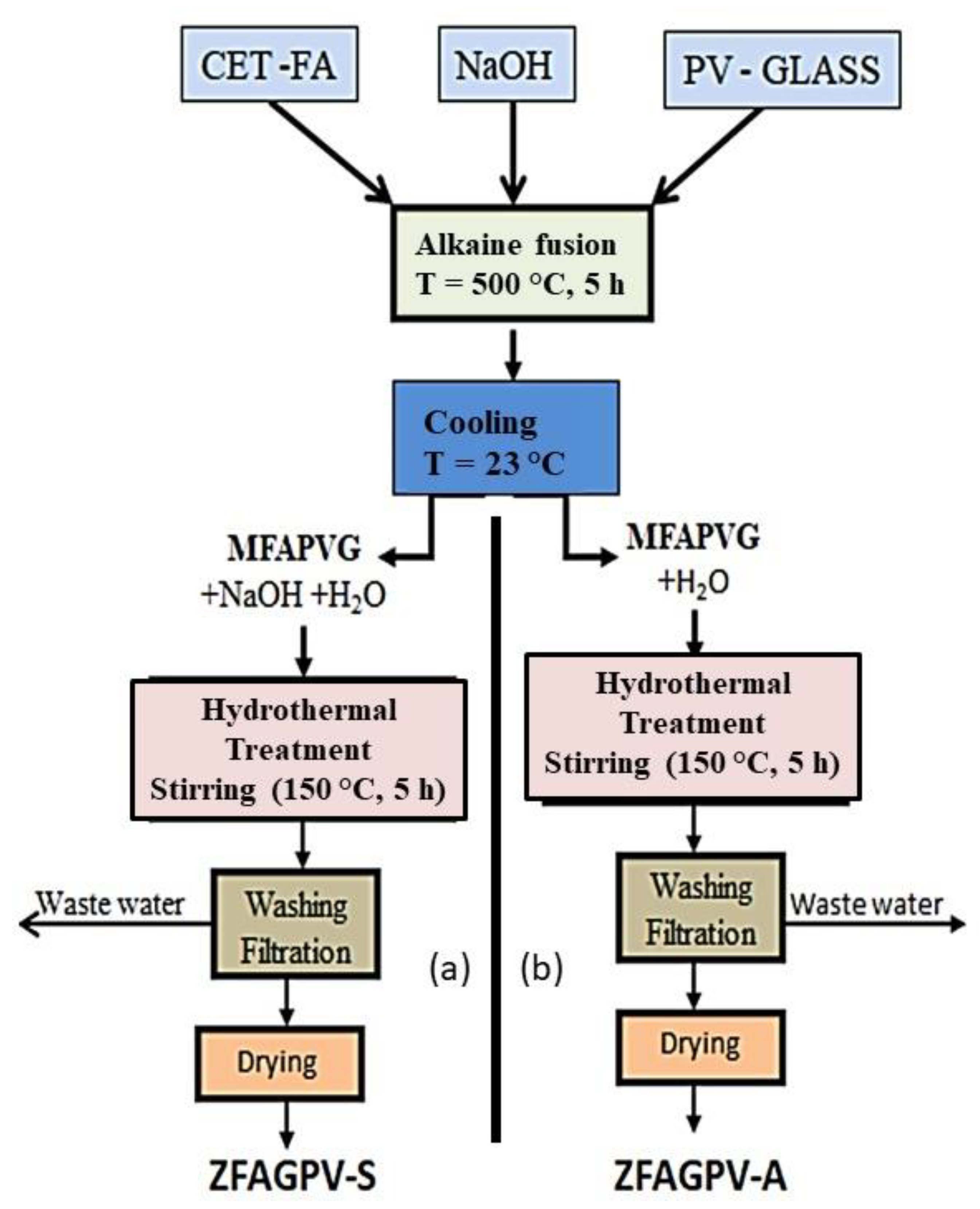
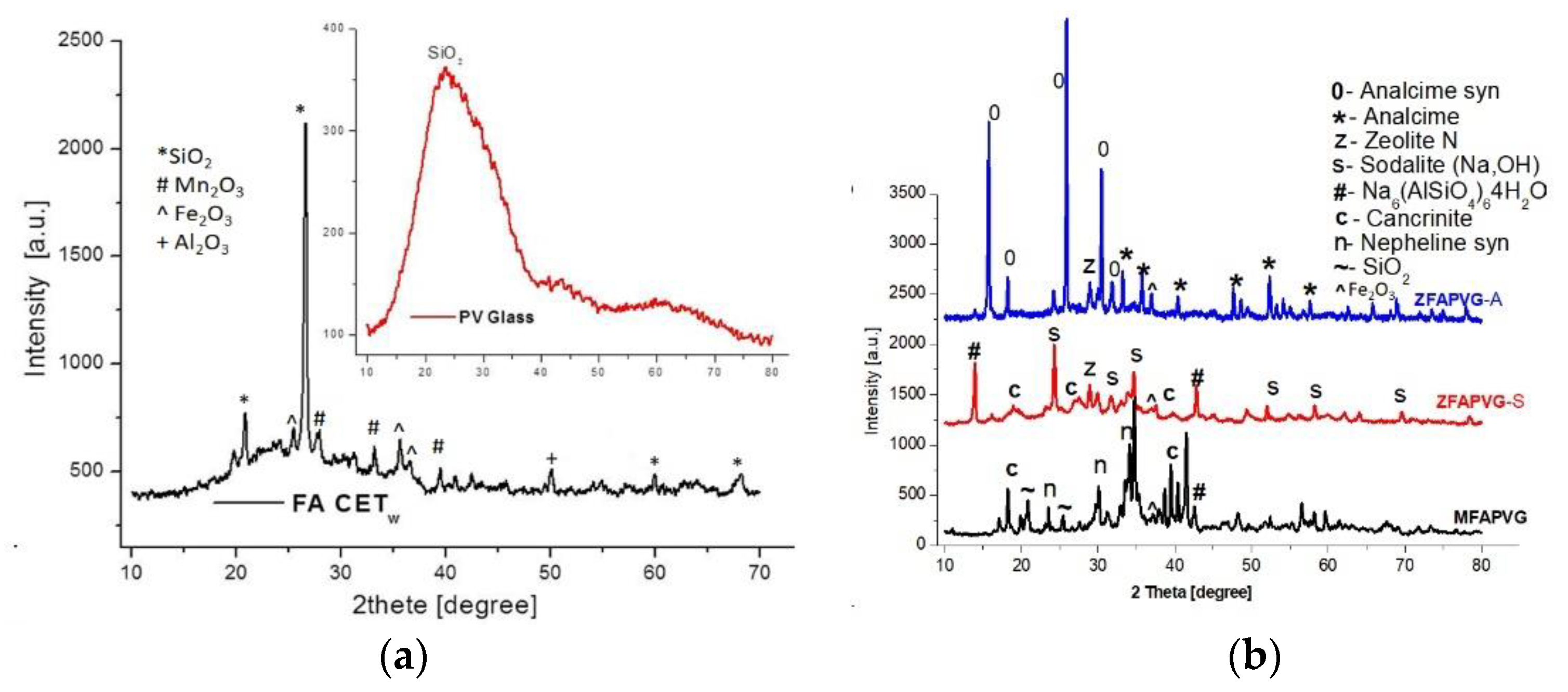


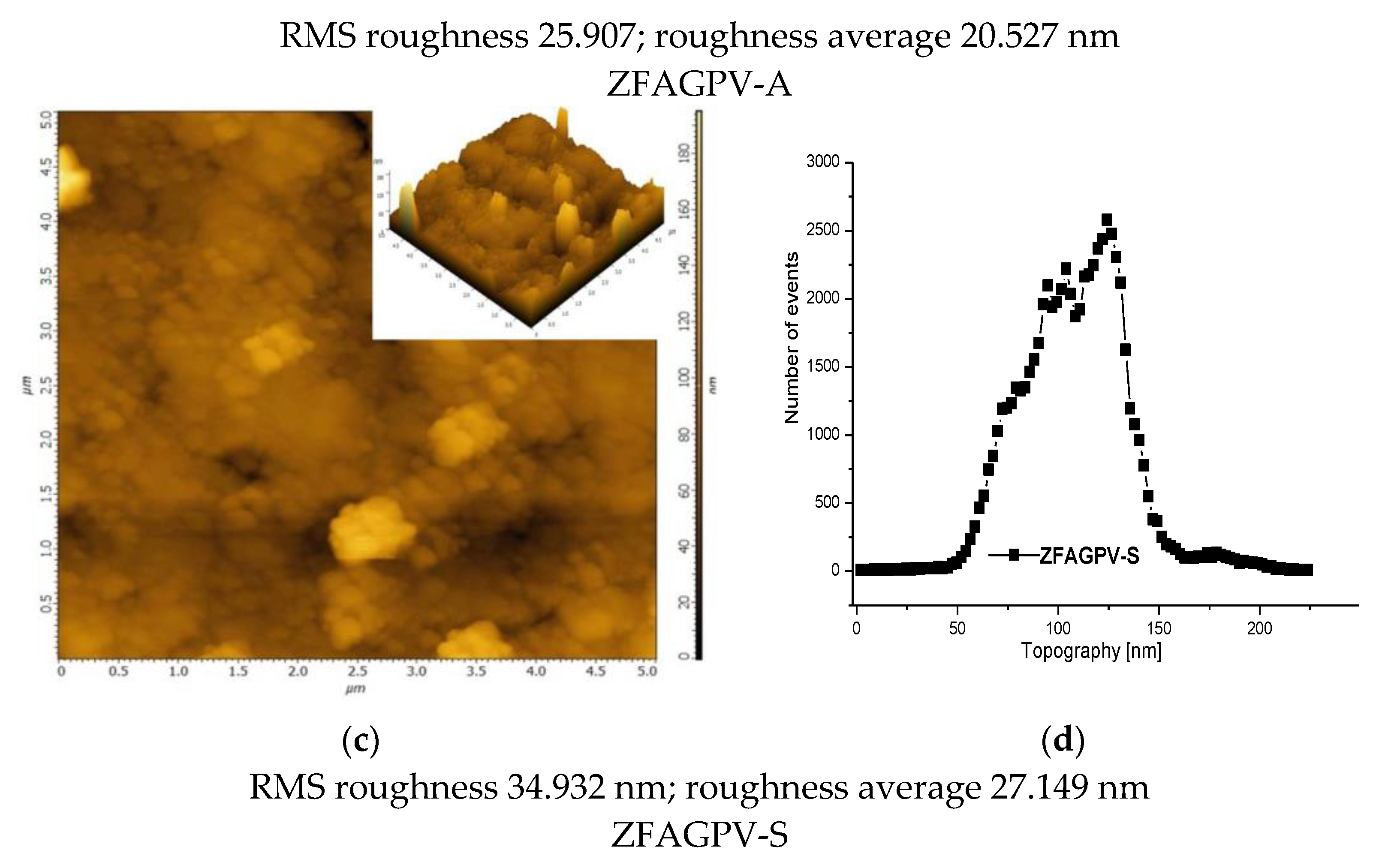
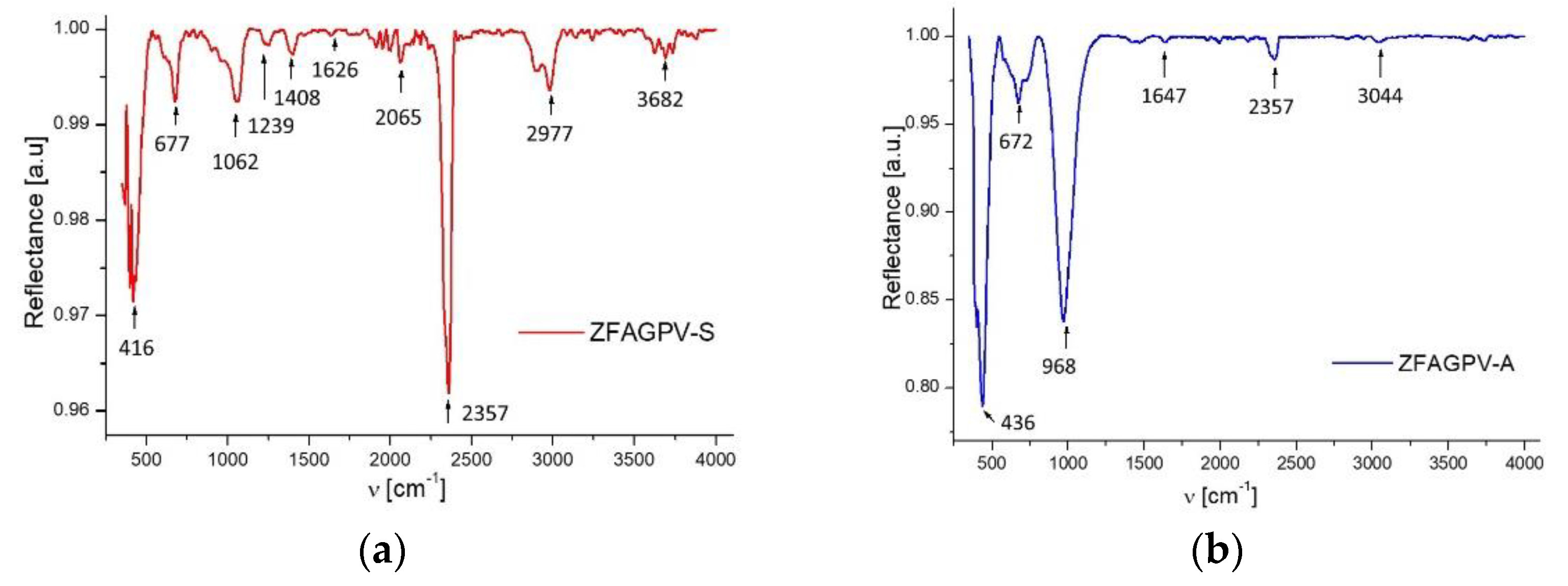

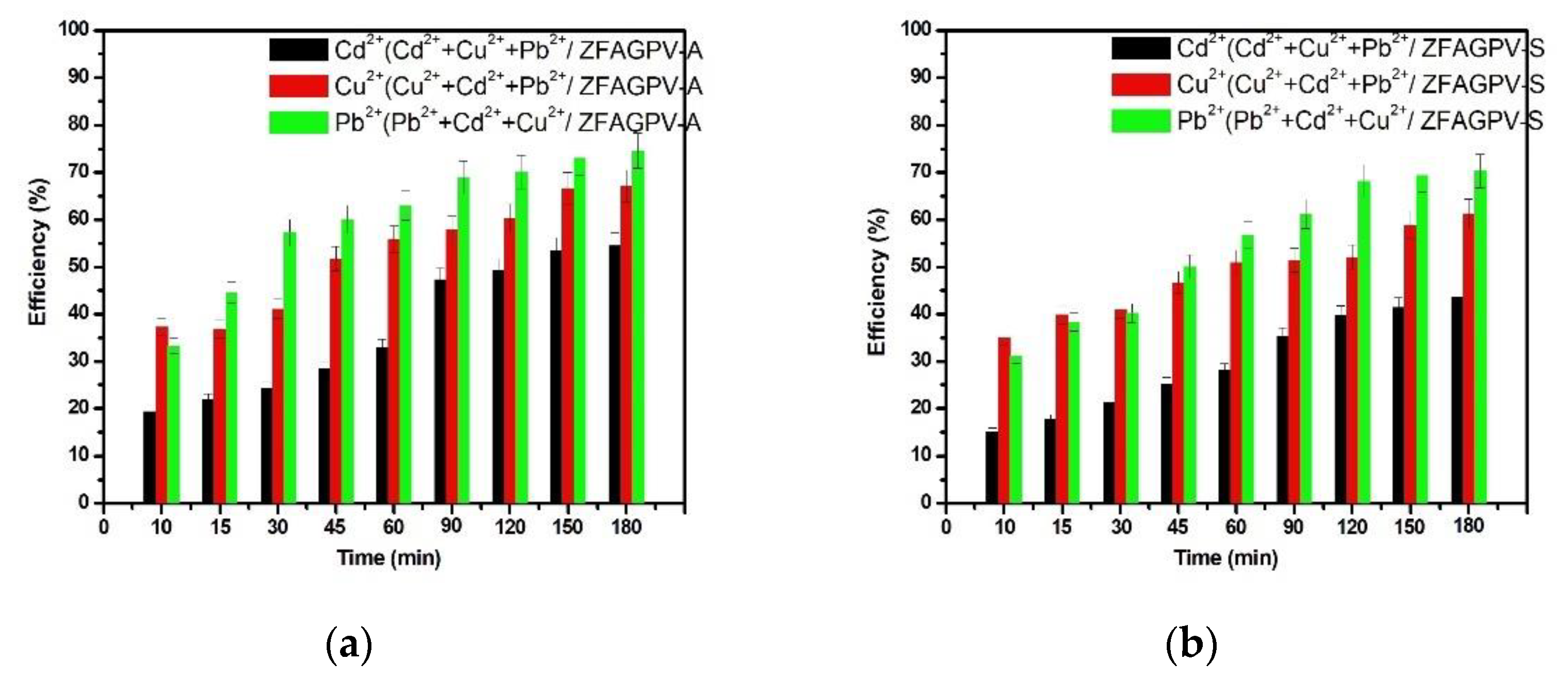



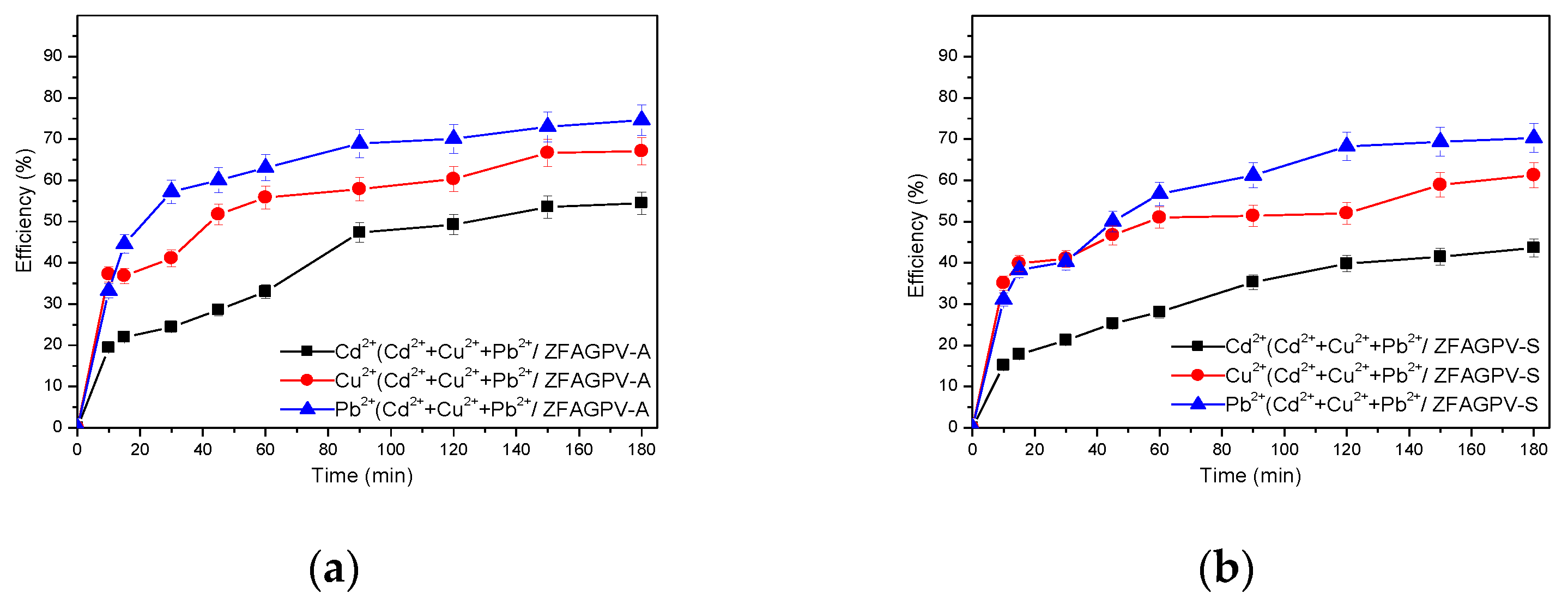
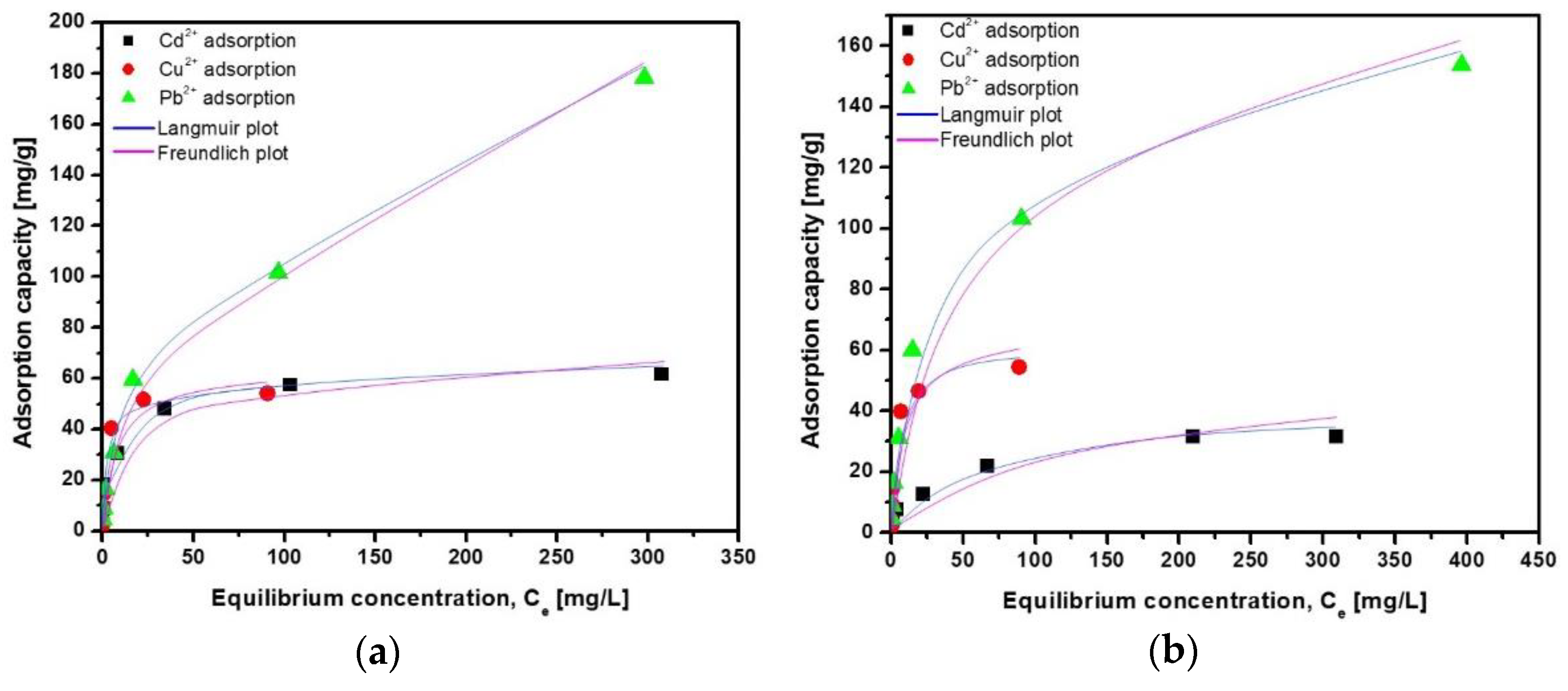
| Sample | SBET (m2/g) | Pore Diameter (nm) | Micropores V. (t-Plot) (cm3/g) | Average Roughness (nm) |
|---|---|---|---|---|
| FA | 6 | 27.20 | 0.004 | 90.8 |
| ZFAGPV-S | 49 | 11.67 | 0.015 | 27.149 |
| ZFAGPV-A | 63 | 19.84 | 0.018 | 20.527 |
| FA | PV Glass | ZFAPVG-A | ZFAPVG-S | |||
|---|---|---|---|---|---|---|
| Element Line | Element Wt. (%) | Element Wt. (%) | Element Wt. (%) before Adsorption | Element Wt. (%) after Adsorption | Element Wt. (%) before Adsorption | Element Wt. (%) after Adsorption |
| O K | 38.89 | 49.32 | 56.21 | 17.20 | 50.47 | 25.99 |
| Na K | 7.51 | 10.72 | 4.21 | 14.71 | 8.86 | 10.97 |
| Al K | 17.31 | 0.72 | 2.04 | 4.40 | 1.30 | 9.41 |
| Si K | 26.93 | 30.11 | 31.88 | 23.19 | 31.97 | 8.26 |
| K K | 3.85 | 0.00 | 5.71 | 0.00 | 7.40 | - |
| Mg K | 1.29 | 1.65 | - | - | - | - |
| Cu | - | - | - | 5.16 | - | 12.53 |
| Cd | - | - | - | 4.35 | - | 3.38 |
| Pb | - | - | - | 30.99 | 16.10 | |
| Sample | θwater (°) | θglycerol (°) | Surface Energy σ | Surface Energy σ (mN/m) | |
|---|---|---|---|---|---|
| σ Polar (mN/m) | σ Dispersive (mN/m) | ||||
| FA | 110.2–10.8 | 32.6–33.8 | 46.09 | 23.87 | 69.96 |
| ZFAGPV-S | 11.6–10.4 | 31.6–30.1 | 106.96 | 27.14 | 134.1 |
| ZFAGPV-A | 18.7–17.8 | 38.2–38.1 | 115.77 | 42.78 | 158.55 |
| Allocation Characteristics Groups | ZFAGPV-S (cm−1) | ZFAGPV-A (cm−1) |
|---|---|---|
| Si–OH, Al–OH, hydroxyl groups stretching/vibration OH groups bridging hydroxyls in zeolite cages to the same Al–OH–Si | 3682 | 3044 |
| O–H (bonding water molecules) zeolitic water. | 1626 | 1647 |
| Internal tetrahedral Asymmetric stretching vibration of Si–O; Al–O bonds Asymmetric stretching vibration of Si–O–Al | 1062 1239 1408 | 968 |
| External linkage Symmetric stretching vibration ties Al–O; Si–O Bending vibration of the links –O; Si–O; Al–O–Si; Fe–O bond of the zeolite structure | 677 | 672 |
| Vibration of the open pores, band Si–O–Si | 416 | 436 |
| Metal Ions | Cd2+ | Cu2+ | Pb2+ |
|---|---|---|---|
| Electronegativity (eV) | 1.7 | 1.9 | 1.9 |
| Radius of the anhydrous ions (nm) | 9.7 × 10−2 | 7.2 × 10−2 | 12.2 × 10−2 |
| Hydration index | 6 | 4…to 6 | >4 |
| Radius of the hydrated ions (nm) | 42.6 × 10−2 | 29.5 × 10−2 | 26.1 × 10−2 |
| Substrate | Pseudofirst Order | Pseudosecond Order | Intraparticle Diffusion | |||||||
|---|---|---|---|---|---|---|---|---|---|---|
| KL (min−1) | qe(exp) (mg/g) | R2 | k2 (g mg−1min−1) | qe(cal) (mg/g) | h (mg/g·min) | R2 | Kid (mg/g min0.5) | C (mg/g) | R2 | |
| Cadmium | ||||||||||
| ZFAGPV-A | 0.016 | 213.8 | 0.973 | 0.03 | 217.39 | 1616.3 | 0.999 | 6.27 | 134.57 | 0.901 |
| ZFAGPV-S | 0.023 | 168.1 | 0.907 | 0.06 | 178.57 | 1826.2 | 0.999 | 5.28 | 103.75 | 0.866 |
| Copper | ||||||||||
| ZFAGPV-A | 0.033 | 150.6 | 0.983 | 0.061 | 158.7 | 1526.8 | 0.999 | 6.20 | 78.53 | 0.859 |
| ZFAGPV-S | 0.016 | 125.8 | 0.979 | 0.106 | 131.6 | 1833.4 | 0.996 | 5.36 | 56.85 | 0.941 |
| Lead | ||||||||||
| ZFAGPV-A | 0.023 | 488.8 | 0.831 | 0.003 | 500.0 | 750.0 | 1 | - | - | 0.543 |
| ZFAGPV-S | - | 491.3 | 0.782 | 0.004 | 500.0 | 925.0 | 0.999 | 3.342 | 445.08 | 0.882 |
| Cadmium from (Cd2++Cu2++Pb2+) system | ||||||||||
| ZFAGPV-A | 0.024 | 148.7 | 0.923 | 0.236 | 181.8 | 7804.9 | 0.968 | 10.41 | 16.069 | 0.962 |
| ZFAGPV-S | 0.019 | 119.0 | 0.971 | 0.266 | 140.9 | 5270.7 | 0.981 | 7.935 | 16.70 | 0.980 |
| Copper from (Cd2++Cu2++Pb2+) system | ||||||||||
| ZFAGPV-A | 0.015 | 103.0 | 0.943 | 0.153 | 111.1 | 1888.0 | 0.993 | 4.852 | 41.615 | 0.850 |
| ZFAGPV-S | 0.012 | 89.04 | 0.946 | 0.143 | 97.09 | 1347.0 | 0.989 | 8.149 | 27.744 | 0.971 |
| Lead from (Cd2++Cu2++Pb2+) system | ||||||||||
| ZFAGPV-A | 0.021 | 374.6 | 0.972 | 0.034 | 400.0 | 5440.0 | 0.999 | 17.69 | 160.21 | 0.865 |
| ZFAGPV-S | 0.026 | 352.9 | 0.967 | 0.054 | 400.0 | 8672.0 | 0.994 | 19.81 | 109.97 | 0.954 |
| Langmuir Isotherm | Freundlich Isotherm | |||||||
|---|---|---|---|---|---|---|---|---|
| Substrate | qmax (mg/g) | Ka (L/mg) | RL | R2 | 1/n | n | Kf (L/mg) | R2 |
| Cadmium | ||||||||
| ZFAGPV-A | 55.55 | 0.428 | 0.111–0.004 | 0.999 | 0.305 | 3.279 | 5.098 | 0.881 |
| ZFAGPV-S | 33.44 | 0.055 | 0.591–0.0347 | 0.989 | 0.370 | 2.696 | 0.009 | 0.991 |
| Copper | ||||||||
| ZFAGPV-A | 60.11 | 0.627 | 0.179–0.0051 | 0.998 | 0.431 | 2.316 | 5.4598 | 0.937 |
| ZFAGPV-S | 54.94 | 0.915 | 0.131–0.0035 | 0.999 | 0.411 | 2.431 | 4.1885 | 0.933 |
| Lead | ||||||||
| ZFAGPV-A | 175.43 | 0.038 | 0.179–0.0052 | 0.951 | 0.486 | 2.056 | 2.1291 | 0.988 |
| ZFAGPV-S | 158.73 | 0.054 | 0.512–0.0178 | 0.981 | 0.458 | 2.179 | 3.2675 | 0.988 |
Disclaimer/Publisher’s Note: The statements, opinions and data contained in all publications are solely those of the individual author(s) and contributor(s) and not of MDPI and/or the editor(s). MDPI and/or the editor(s) disclaim responsibility for any injury to people or property resulting from any ideas, methods, instructions or products referred to in the content. |
© 2022 by the authors. Licensee MDPI, Basel, Switzerland. This article is an open access article distributed under the terms and conditions of the Creative Commons Attribution (CC BY) license (https://creativecommons.org/licenses/by/4.0/).
Share and Cite
Visa, M.; Enesca, A. Opportunities for Recycling PV Glass and Coal Fly Ash into Zeolite Materials Used for Removal of Heavy Metals (Cd, Cu, Pb) from Wastewater. Materials 2023, 16, 239. https://doi.org/10.3390/ma16010239
Visa M, Enesca A. Opportunities for Recycling PV Glass and Coal Fly Ash into Zeolite Materials Used for Removal of Heavy Metals (Cd, Cu, Pb) from Wastewater. Materials. 2023; 16(1):239. https://doi.org/10.3390/ma16010239
Chicago/Turabian StyleVisa, Maria, and Alexandru Enesca. 2023. "Opportunities for Recycling PV Glass and Coal Fly Ash into Zeolite Materials Used for Removal of Heavy Metals (Cd, Cu, Pb) from Wastewater" Materials 16, no. 1: 239. https://doi.org/10.3390/ma16010239



_CHAINOK.jpg)


